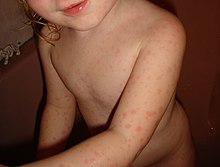Erythema exudativum multiforme
| Classification according to ICD-10 | |
|---|---|
| L51 | Erythema exudativum multiforme |
| ICD-10 online (WHO version 2019) | |
Erythema (exudativum) multiforme describes an acute inflammatory disease of the skin or mucous membrane . This skin disease often occurs 1–2 weeks after infection . This indicates an immunological reaction . The cause can also be a reaction to certain pollutants and preservatives (e.g. triclocarban ). Recurrences are common. Painful swelling of the joints can also occur. An antihistamine (e.g. Fenistil gel) has proven itself here.
There are two forms:
- Erythema multiforme minus: typical skin foci with missing / weak bladder components, mostly on the back of the hand or forearm.
- Erythema multiforme majus: typical skin foci with generalized central blistering ( cockade ) including the feet and palms, these appear as so-called " target lesions ". This can lead to erosion of the oral mucosa and severe skin involvement. Triggers can be both different viruses (e.g. herpes simplex viruses ) and different drugs. There is a smooth transition to Stevens-Johnson Syndrome .
Cooling (cooling pads, moist compresses) and pain relievers bring relief. Possibly. an antiallergic agent (e.g. cetirizine ) can provide quick relief.
literature
- Lamoreux MR, Sternbach MR, Hsu WT. Erythema multiforme. At the Fam Physician. 2006 Dec 1; 74 (11): 1883-8. Review. PMID 17168345
- Peter Fritsch, dermatology and venereology for the degree
- Wolfram Sterry, Short Textbook Dermatology, Thieme Verlag 2011
Individual evidence
- ↑ D. Leroy, S. De Raucourt, P. Deschamps: Drug-induced erythema multiforme with photodistribution and genital lesions. In: Photo-dermatology. Volume 4, Number 1, February 1987, pp. 52-54, ISSN 0108-9684 . PMID 2956580 .
